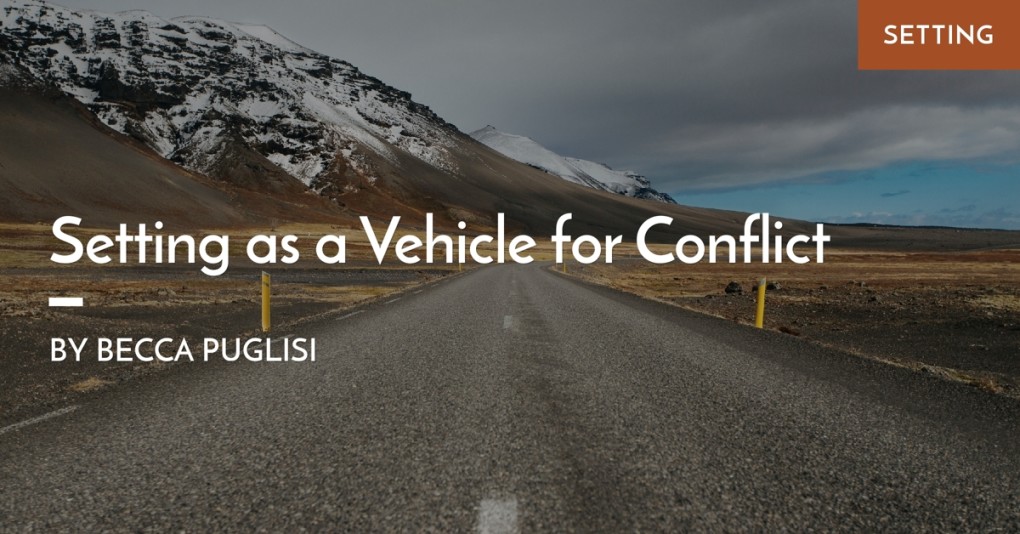by Becca Puglisi, @BeccaPuglisi
I’m sure you’ve heard the saying that a good book should have conflict in every scene. This is wise advice, since well-written conflict begets tension for our characters, which can be passed on to readers, who will sense a rise in energy as they feel that nervous, jittery sensation signaling them that something is going on. We all want readers to have that heightened awareness and interest when they’re reading our stories, and a good way to bring that about is through conflict.
While the most obvious source of conflict is an antagonist who opposes our hero and his goal, it’s simply not reasonable (or sensible) to drag him into every chapter. As a result, we have to find other struggles that make sense for each scene. It may not seem like the most intuitive choice, but I’d like to propose that the setting is one of the handiest sources of conflict, for a number of reasons. First, every scene has a setting, so it’s already built into your story. And with the sources of conflict inherently included in each location, there’s no need to fabricate them—no lengthy set-up involved to put these difficulties into your protagonist’s path. If you’re wondering what sources of conflict I’m referring to, consider the following:
Physical Roadblocks
This kind of conflict is great because it’s so literal. Washed-out roads, a blizzard, the parade that shuts down half a city’s streets—all these obstacles keep the protagonist from getting where he physically needs to be. And roadblocks like these are easily incorporated into a variety of settings. Keep in mind, too, that literal obstructions don’t have to be large and impressive to be effective. A locked door or a small but loud dog can provide the resistance necessary to make things difficult for your character.
Mirrors to a Painful Past
Everyone has baggage—including our characters, if we’ve done our job well in the backstory department. While every location has conflict, there should be some settings that are especially problematic for your protagonist. Forcing him to revisit one of these places at a pivotal point in your story can act as a trigger, heightening his emotions and encouraging a bigger, more dramatic response.
Consider John Rambo, from the movie First Blood. Being arrested on a technicality by a prejudicial sheriff wouldn’t be a pleasant experience for anyone, but most people could navigate the situation and bring it to a resolution. For Rambo, being locked up brings to mind his time as a POW. When he’s taunted by a group of officers and threatened with a straight razor—the same item used to torture him in Vietnam—he flips out. His current situation directly mirrors a traumatic experience from the past, and he reacts violently, setting in motion a series of events that can’t be undone or made right.
If you know your character’s past, you’ll know which settings can act as emotional triggers. To ramp up the conflict and tension in an important scene, have your protagonist revisit one of those places.
Peripheral Troublemakers
While the antagonist should be the Biggest Baddie in your story, there are plenty of other rabble-rousers that can make things difficult for your hero, and you don’t have to go far afield to find them. You usually don’t have to look past the people who naturally inhabit your setting.
Let’s take a fitness center, for instance—not exactly the most combative location. But there are so many people naturally found here who could provide conflict: inexperienced guests, demanding trainers, overzealous managers pushing memberships, competitive guests with huge egos, ‘roid-raging bodybuilders…the list goes on and on.
The truth is that every setting has its own built-in cast of troublemakers. So when it comes time to write a scene, ask yourself: what does my hero want to achieve here? Consider what kind of characters might get in his way, then pick a setting where those people abound, and voilà: instant conflict.
Family Dysfunction
It’s sad to say, but in real life, it’s not the strangers and acquaintances that cause us the most heartache and drama. Usually, it’s our family members. Because of our history with them, tension easily builds before they’ve even done anything. They’re great at pushing our buttons, and their constant proximity makes us more sensitive to their quirks and jabs.
If you’re looking to add some tension to a scene, set it in a location where certain family members are likely to turn up: the backyard, a child’s birthday party, the shopping mall, or at church. Then sit back and watch the sparks fly.
The beauty of using a setting to provide conflict is that you can approach it from a number of ways. One method is to choose a setting based on the conflict needs of your scene. With this approach, the location is flexible; it can be any of a number of places. As you plan out your scene, decide what brand of conflict is necessary and choose a locale that contains that kind of trouble. Alternatively, if you already have a place in mind for a given scene, look for naturally occurring sources of conflict within that setting and use them to ramp up the tension. Either way, the location you choose can provide a ton of realistic conflict for your story.
As you can see, the setting is an incredibly versatile tool that can do more than simply set the stage. Turn your lazy locale into a multitasking one by using it to ramp up the tension in every scene.
 Becca Puglisi is an international speaker, writing coach, and bestselling author of The Emotion Thesaurus and its sequels, including The Rural Setting Thesaurus and The Urban Setting Thesaurus, which will be available for purchase in June. She is passionate about learning and sharing her knowledge with
Becca Puglisi is an international speaker, writing coach, and bestselling author of The Emotion Thesaurus and its sequels, including The Rural Setting Thesaurus and The Urban Setting Thesaurus, which will be available for purchase in June. She is passionate about learning and sharing her knowledge with  others through her Writers Helping Writers blog and via One Stop For Writers—a powerhouse online library filled with description and brainstorming tools to help writers elevate their storytelling. You can find Becca online at both of these spots, as well as on Facebook and Twitter.
others through her Writers Helping Writers blog and via One Stop For Writers—a powerhouse online library filled with description and brainstorming tools to help writers elevate their storytelling. You can find Becca online at both of these spots, as well as on Facebook and Twitter.

Hi Elizabeth – what a great guest … and Setting does put the brain into gear when we read … I’m sure this will be an essential reference for many an author and writer … cheers and thanks Becca – Hilary
Hilary–Isn’t it a great post? Thanks, Becca, for posting today. I tend to shortchange setting and this helps remind me how important it is.
Thanks so much for letting me crash your pad :).
Hi Elizabeth!
Hi Benjamin!
It was my pleasure, Hilary! Angela and I learned so much while writing these Setting Thesaurus books, and we were really surprised to discover how much the setting can do. Hopefully, the books will help writers to maximize their settings :).
All of those things are very believable, too.
Thanks for popping in!
There’s always troublemakers at the work place!
LOL. Too true.
Thanks for your thoughts on this. I agree that setting can be a really important part of the conflict in a story. In fact, the setting itself can be a source of conflict (e.g. people at a ski lodge when the weather turns bad). Lots to think about here, for which thanks.
Absolutely true! The setting can be so versatile when it comes to providing conflict for our characters.
Love this list of conflicts. When there is conflict in our stories, the better one feels when things are resolved or at least are managed.
Teresa
Thanks for reading, Teresa!
Great point. Conflict is critical, but also is resolution.
Great post, Becca!
I love those little annoyances (in books, not in RL! :)) that irritate and aggravate and set people’s teeth on edge. They can add a lot of angst!
I agree. We often think of conflict in these huge, melodramatic terms, but it doesn’t usually take that much to tip our characters over the edge. Those little annoyances are often the most realistic ones and they do the job perfectly well.
Love the post, Becca! Since description and setting are my weakness, I’ve been spending a lot of time trying to improve. Can’t wait for your setting books!
Good for you, Carrie! We learned a lot ourselves while we were writing the Setting Thesaurus books, so I hope they help you a bunch!
Some settings become actual antagonists in some books as with Craig Johnson’s HELL IS EMPTY with the Big Horn Mountains and my own FRENCH QUARTER NOCTURNE set in New Orleans after Katrina. Best of sales!
Thanks, Roland! Good point: Middle Earth has quite a few example of this, too.
Such an excellent post. I love when a setting is actually a metaphorical representation of the true conflict. It doesn’t click with most readers, but there’s a subconscious recognition that makes the message ring that much truer.
Hi Becca,
Love your post! Makes a alot of sense and resonates on many levels. I’m definitely looking forward to getting both setting books. Already have all of the others, so they’ll add to my collection.
Thanks
Benjamin